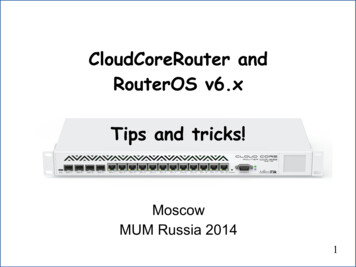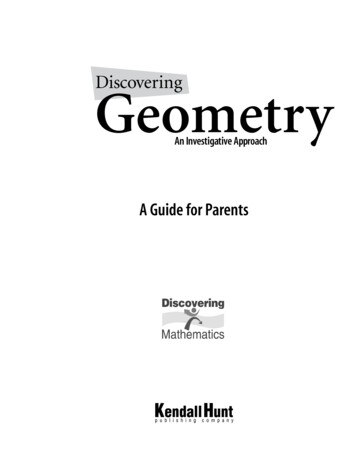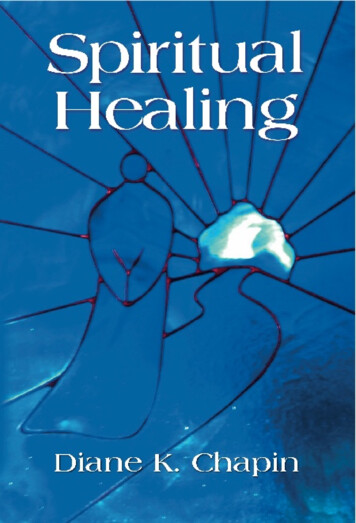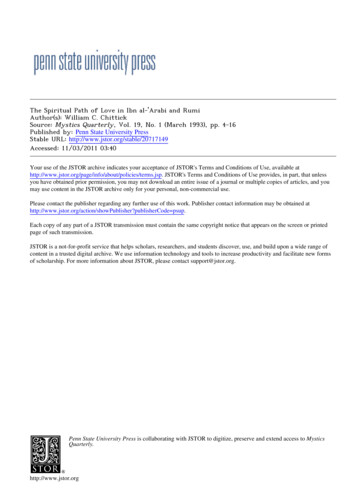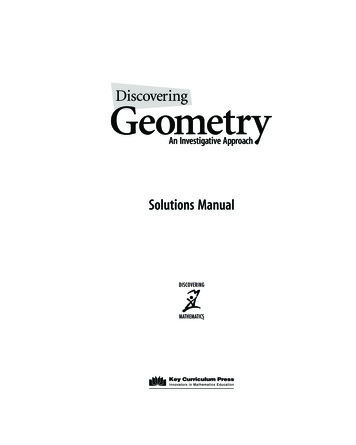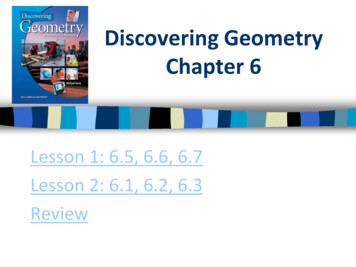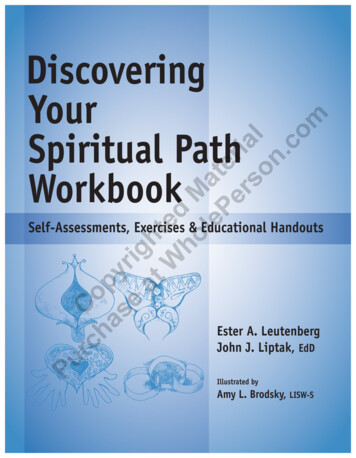
Transcription
rc Coha pse yrigat hW tedho Mle atPe errs ialon.comDiscoveringDiscoveringYour YourSpiritualPathSpiritual PathWorkbookWorkbookSelf-Assessments, Exercises & Educational HandoutsSelf-Assessments, Exercises& Educational HandoutsEster A. LeutenbergJohn J. Liptak, EdDIllustrated byPuAmy L. Brodsky, LISW-SEster A. LeutenbergJohn J. Liptak, EdDIllustrated byAmy L. Brodsky, LISW-S
rc Coha pse yrigat hW tedho Mle atPe errs ialon.comDiscoveringYourSpiritual PathWorkbookSelf-Assessments, Exercises& Educational HandoutsEster A. LeutenbergJohn J. Liptak, EdDIllustrated byPuAmy L. Brodsky, LISW-S
rc Coha pse yrigat hW tedho Mle atPe errs ialon.comWhole Person Associates101 West 2nd Street, Suite 203Duluth, MN comDiscovering Your Spiritual Path WorkbookSelf-Assessments, Exercises & Educational HandoutsCopyright 2010 by Ester A. Leutenberg and John J. Liptak.All rights reserved. Except for short excerpts for review purposesand materials in the assessment, journaling activities, andeducational handouts sections, no part of this book may bereproduced or transmitted in any form by any means, electronicor mechanical, including photocopying without permission inwriting from the publisher.Printed in the United States of AmericaEditorial Director: Carlene SippolaArt Director: Joy Morgan DeyPuLibrary of Congress Control Number: 2009941904ISBN: 978-1-57025-237-2
DedicationDiscovering Your Spiritual Path Workbook is lovingly dedicated to Kathy Atarah Khalsa,who in 1987 lighted the way.Thanks to the following people who completed our spirituality survey and/or suggestedfavorite spirituality books for our reference pages in the last chapter:Fritz ClarkeRisa Dorf-BrooksDolores DowlingArlyne DruckmanEric DunnLisa Brauer EisenstatOsmond EkwuemeDiane EmisonGreg E. FortierLois FrankPenelope FreseHarriet GallenChuck GeorgeAndy GetzAurelie Jones GoodwinBernice GrantSheryl HirshDenny HirshDavid HirschhornRon HuntDavid JanzenRobert JensenLeah KamionkowskiKathy KhalsaSiri-Dya KhalsaAllen KleinArielle KorbMason KorbShayna KorbJudy KrausserCorinne KulickWilliam KurschinskiTamar LevyBeatrice LewisDouglas LinkAnne LoweChrista LubatkinMike LubatkinPrahaladan MandelkornJack MartinNannie MaxwellBetty Welch McGaugheyRichard McQuateLeona MitchellKerry MolesBruce K. MunroBelleruth NaparstekSandra NegleyAbraham NelsonJim PhillipsPauline RaymondJoanne RebaEileen RegenScott RegenLucy RitzicCarol RosnerPeggy Gawiser ShecketDeborah ScheinJeffrey ScheinSteve SegarDonald ShieldsBailey SmithMary Ann StakyJulie StonebergCindy ThomasDon TuskiErv WalhofRobert WallinGerard I.WillgerGayl WoityraJoel WolinskyLynne YulishFran Zamorerc Coha pse yrigat hW tedho Mle atPe errs ialon.comManohar AhujaDon AndersonBrenda Gottlieb AtkinJeffrey AtkinRondi AtkinGene BammelStephen BarnusskiHalle BarnettJeff BartonIan BeatonGeorge BestDavid BirvirtJoan BirvirtJoe BolzeSandie BolzeSheli BraunJoan BrauerJim BrineySandra BrineyAmy BrodskyCarol A. ButlerDelores CarlPaul ChorneyShirley R. ChorneySpecial thanks for the time and expertise of the following professionalswhose input in Discovering Your Spiritual Path Workbook has been so valuable!Rev. James Briney, B.A., M. Div.Kathy A. Khalsa, MAJS, OTR/LShayna Korb, BSCorinne Kulick, OTRKathy Liptak, Ed.D.Eileen Regen, M.Ed., CJELucy Ritzic, OTR/LDeborah Schein, M.Ed.Rabbi Jeffrey Schein, Ed.DRev. Donald Shields, BRE, MTSWith gratitude and ongoing THANK YOUs to:PuAmy L. Brodsky, LISW-Swhose creative, thought-provoking illustrations continue to give our workbooks added meaning.Jay Leutenbergwhose years in the printing business brings the editing and proofreading of our books to a higher level.Eileen Regen,an editor, proofreader and consultant extraordinaire.Carlene Sippola, Publisher, Whole Person Associateswho provides a broad range of products based on a whole person approach that considersmental, emotional, social, spiritual and lifestyle issues. We are so appreciative of her faith in us.
V.I.P. Very Important for the ProfessionalOur goalrc Coha pse yrigat hW tedho Mle atPe errs ialon.comOur goal for Discovering Your Spiritual Path Workbook’s assessments, activities, journalingpages, quotations and educational handouts is to open participants to the possibilitiesof spirituality and its benefits. We believe people on a spiritual path lead more healing,enriching, enlightening, peace-filled lives. We interviewed over one hundred people of manydifferent faiths and economic backgrounds. We spoke to people of varied ages, genders,sexual orientations, cultures, nationalities and religions. We were privileged to discuss thetopic presented with believers and non-believers and clergy of most every faith before weeven began the process of writing this book.Defining and Addressing Individual SpiritualityEach person we interviewed had different opinions and beliefs about spirituality. Some hadnone. Our challenging task was opening a topic so complex and immense, and not appearingover simplistic, condescending, incomplete or confusing. Since spirituality can be a sensitivesubject, we avoided over-using the word spirituality and we focused on the topics we feltwere the components of spirituality, to gather the greatest variety of honest responses andideas, as well as to encourage a wide range of thought processes.We asked these questions: Are you . . .1.) spiritual, but not religious?2.) religious, but not spiritual?3.) religious and spiritual?4.) neither religious nor spiritual?In what way is your spirituality connected with your religion?How would you define spirituality?What/where do you feel your spirituality or a genuine warm feeling?Which situations feel non-spiritual or irritating?Shayna Korb, aspacewithin.com, used thematic analysis to create the following categoriesthat represent definitions of spirituality from the one-hundred plus participants whocompleted our survey:PuHealing/Growth — a force toward greater individual or world healthUnderstanding/Meaning/Answers — the drive towards greater knowingConnection — a related or connected feelingFeeling — a particular sense-state, (e.g. a state of flow perceived in quiet moments ormoments of meditation)Force God/Higher Power — some kind of relationship to a higher powerInner/Within — an internal construction, a knowing insideEnergy/Metaphysics — awareness of an underlying energy or reality undefined bycontemporary scienceNegative Case — people who do not see themselves as spiritual, define spirituality in anegative way or have no understanding or definition of spirituality at all.(Continued on the next page)
V.I.P. Very Important for the Professional (page 2)Defining and Addressing Individual Spirituality (Continued)rc Coha pse yrigat hW tedho Mle atPe errs ialon.comAnother one of our goals was to find the PERFECT definition of spirituality. Spirituality is adifficult concept to define because it can mean many different things to different people.Defining spirituality is individual and personal. We hope that our readers’ felt-sense ofspirituality can connect to one or more of the multiple frameworks presented in this text.We believe the chapters in this book reflect components of spirituality that can be useful toeveryone, regardless of how they define spirituality.For the purposes of this book, we define religion as a set of beliefs and practices based on aspecific religious doctrine. We attempt to differentiate spirituality from religion. In DiscoveringYour Spiritual Path Workbook we are focusing primarily with spirituality, not religion (althoughreligion can be a part of spirituality). We have purposefully avoided much discussion ofreligion, allowing the facilitator to use personal judgment to the extent that religion plays apart in this process for each individual.We have included a handout, Definitions Of Spirituality, in the participant’s section in thischapter. It consists of several of the definitions from our surveys that seem to representmost of the responses in some way. You may choose to read the definitions aloud to theparticipants, with the hope that one of the quotations might set off a spark, a thought or anidea for those who are unsure of how to define spirituality. The quotations may help thosewho do feel some level of spirituality verbalize their ideas. Either way, participants may findsomething with which to identify. After the definitions page are the handouts When/Where DoYou Feel Your Spirituality or a Genuine Warm Feeling? and Which of These Feel Non-Spiritual orIrritating? These can be used as pre- and post-discussion tools or warm-ups before you beginfacilitating the book, afterwards, or both.The Nature of SpiritualityWellness includes six important dimensions: occupational, social, emotional, intellectual,physical and spiritual. The spiritual dimension, according to the National Wellness Institute*,recognizes the search for meaning and purpose in human existence. This search includes thedevelopment of a deep appreciation for the depth and expanse of life and natural forces thatexist in the universe.It will help to keep several tenets in mind as your clients explore spiritual themes in their lives: This spiritual search will be characterized by a peaceful harmony between their internalpersonal feelings and the external realities that exist in their lives.Pu While conducting this search, they may experience feelings of doubt, despair, fear anddisappointment as well as feelings of joy, happiness, contentment and discovery. Theseimportant experiences and components to their search will be displayed in the valuesystem they adapt to bring meaning to their existence. They will know they are becoming spiritual or more spiritual when their actionsbecome more consistent with their beliefs and values, resulting in a “world view.”*Hettler, B. (2004). Six dimensional model of wellness. Stevens Point, WI: National Wellness Institute.www.nationalwellness.org.(Continued on the next page)
V.I.P. Very Important for the Professional(page 3)The Nature of Spirituality (Continued)In the book, Spirituality for Dummies*, Sharon Janis suggests some of the ways that spiritualitycan manifest itself:rc Coha pse yrigat hW tedho Mle atPe errs ialon.com Experiencing a higher universal love Surfing the waves of life with a light-hearted view that nurtures a positive sense ofhumor Achieving the ability to see the spiritual in one’s ordinary life Developing a mature approach to life that includes peacefulness and spirituality Experiencing the divine through faith, optimism and an unfettered heart Trusting one’s own inner guidancePreparing to Use the WorkbookDiscovering Your Spiritual Path Workbook contains five separate sections to help participantslearn more about themselves and their spiritual natures. They will learn about the importanceof spirituality, their ability to integrate spirituality into their everyday lives, and tools andtechniques to enhance their spiritual awareness.Sections of this book are:1) Forgiveness and Acceptance Scale helps individuals explore their ability to forgivethemselves and forgive other people.2) Connecting with Others Scale helps individuals explore the strength of theircharacteristics related to connecting with other people.3) Spiritual Living Scale helps individuals identify how effective they are at integratingspiritual themes into their daily lives.4) Personal Centering Scale helps individuals explore their use of the various spiritualdisciplines for finding peace and centering themselves, even when facing life’schallenges.5) Spiritual Awareness Scale helps individuals explore how aware they are of theirspiritual nature.6) The Last Chapter helps individuals process what they have learned from DiscoveringYour Spiritual Path Workbook.PuThe five sections of this book are intended to serve as avenues for individual self-reflection,as well as for group experiences revolving around identified topics of importance. Eachassessment includes directions for easy administration, scoring and interpretation, andprovides exploratory activities, reflective journaling activities, related quotations andeducational handouts. All materials have been designed to help participants discover theirspirituality in a variety of ways.*Janis, S. (2008) Spirituality for Dummies. Wiley, John & Sons, Inc.
The Assessments, Journaling Activities,Quotations and Educational Handoutsrc Coha pse yrigat hW tedho Mle atPe errs ialon.comThe art of self-reflection goes back many centuries and is rooted in many of the world’sgreatest spiritual and philosophical traditions. Socrates, the ancient Greek philosopher,was known to walk the streets engaging the people he met in philosophical reflection anddialogue. He felt that this type of activity was so important in life that he went so far as toproclaim, “The unexamined life is not worth living!” The unexamined life is one in whichthe same routine is continually repeated without ever thinking about its meaning to one’slife and how this life really could be lived. However, a structured reflection and examinationof beliefs, assumptions, characteristics, and patterns can provide a better understanding,which can lead to a more satisfying life. A greater level of self-understanding about importantlife skills is often necessary to make positive, self-directed changes in the over-used orrepetitious patterns. The assessments and exercises in this book can help promote thisself-understanding. Through involvement in the in-depth activities, the participant claimsownership in the development of positive patterns.Journaling is an extremely powerful tool for enhancing self-discovery, learning,transcending traditional problems, breaking ineffective life habits, and helping to heal frompsychological traumas of the past. From a physical point of view, writing reduces stress andlowers muscle tension, blood pressure and heart rate levels. Psychologically, writing reducessadness, depression and general anxiety, and leads it to a greater level of life satisfaction andoptimism. Behaviorally, writing leads to enhanced social skills, emotional intelligence andcreativity. It also leads to improved writing skills which, in turn, leads to more self-confidencein the workplace. By combining reflective assessment and journaling, participants will beexposed to a powerful method of combining verbalizing and writing to reflect on and solveproblems. Participants will become more aware of their spiritual strengths. They will exploreways to develop strategies to acquire an additional dimension in their lives with which to facelife’s challenges and enhance their daily lives.PuPreparation for using the assessments and activities in this book is important. In orderfor you to be effective in administering the assessments in this book, it is suggested thatyou, the facilitator, complete them yourself. This will familiarize you with the format of theassessments, the scoring directions, the interpretation guides and the journaling activities.Although the assessments are designed to be self-administered, scored and interpreted.This familiarity will help prepare facilitators to answer participants’ questions about theassessments.The Assessments, Journaling Activities, Quotations and Educational Handoutsin Discovering Your Spiritual Path Workbook are reproducible and ready to bephotocopied for participants’ use.
The Assessments, Journaling Activities,Quotations and Educational Handouts (page 2)rc Coha pse yrigat hW tedho Mle atPe errs ialon.comAssessments contained in this book focus on self-reported data and can be used asmaterials for individual self-inventory, partner study, spirituality study groups, classes andtherapeutic supplements by psychologists, counselors, therapists, clergy, religious andspiritual leaders and teachers, activity directors and career consultants.Accuracy and usefulness of the information provided is dependent on the truthfulinformation that each participant provides through self-examination. By being honest,participants help themselves discover their life patterns and uncover information thatmight be keeping them from expanding the dimension of their spiritual path on thewellness continuum.An assessment instrument can provide participants with valuable information aboutthemselves; however, it cannot measure or identify everything about them. The purposes ofthe assessments is not to pigeon-hole certain characteristics, but rather to allow participantsto explore all of their characteristics. Discovering Your Spiritual Path Workbook contains selfassessments, not tests. Tests measure knowledge or whether something is right or wrong.For the assessments in this book, there are no right or wrong answers. These assessmentsask for personal opinions or attitudes about a topic of importance in the participant’sspiritual nature.When administering assessments in this workbook, remember that the items are genericallywritten so that they will be applicable to a wide variety of people but will not account forevery possible variable for every person.PuAdvise the participants taking the assessments that they should not spend too much timetrying to analyze the content of the questions; their initial response will most likely be true.Regardless of individual scores, encourage participants to talk about their findings andtheir feelings pertaining to what they have discovered about themselves. Talking about thecomponents of spirituality can enhance the lives of participants. These exercises can be usedby group facilitators working with any population who may want to explore their spirituality,or with those whom you feel would be open and able to benefit from exploring aspiritual path.
The Assessments, Journaling Activities,Quotations and Educational Handouts (page 3)Layout of the Bookrc Coha pse yrigat hW tedho Mle atPe errs ialon.com Assessment Instrument — Self-assessment inventories with scoring directions andinterpretation materials. Group facilitators can choose one or more of the activitiesrelevant to their participants. Activity Handouts — Practical questions and activities to prompt self-reflection andpromote self-understanding. These questions and activities foster introspection andpromote pro-social behaviors. Reflective Questions for Journaling — Self-exploration activities and journalingexercises specific to each assessment to enhance self-discovery, learning and healing. Educational Handout — Handouts designed to supplement instruction can beused individually or in groups. They can be distributed, converted into masters foroverheads or transparencies, or written on a board and discussed. Quotations — Quotations are included throughout the chapters to motivate andinspire, as well as promote self-reflection and provide insight into the thoughts ofvarious spiritual leaders.Who Should Use This Program?This book has been designed as a practical tool for helping professional therapists,counselors, career counselors and coaches, psychologists, teachers, spiritual and religiousleaders, and group leaders help their clients. Depending on the role of the professional usingDiscovering Your Spiritual Path Workbook and the specific group’s needs, these sections canbe used individually, combined, or implemented as part of an integrated curriculum for amore comprehensive approach.Why Use Self-Assessments?Self-assessments are important in teaching various life skills. Participants will . . . Become aware of the primary motivators that guide their behavior. Explore and learn to indentify challenging situations. Explore the effects of messages received in childhood.Pu Gain insight that will guide greater understanding of one’s spirituality. Focus thinking on behavioral goals for expanding one’s spirituality. Uncover spiritual resources that can help one to cope with problems and difficulties. Explore personal characteristics without judgment. Develop full awareness of personal strengths and spiritual understanding.Because the assessments are presented in a straightforward and easy-to-useformat, individuals can self-administer, score and understand each assessmentindependently.
Introduction for the ParticipantThe intent of Discovering Your Spiritual Path Workbook is to either start you on yourspirituality path or assist you in enriching your present spiritual path. Your spiritual path is anever-moving and changing aspect of life.rc Coha pse yrigat hW tedho Mle atPe errs ialon.comSpirituality is hard to define. We have discovered that it is often what each person believesit to be — and that one’s perception of spirituality can change over and over again. Ininterviews with over one hundred people, we found each person’s definition was differentfrom the others — and yet, each person’s definition is correct as a personal understanding.Many people connect their religion with spirituality and some think religion and spiritualityare different. We hope when you are finished with this book, you are able to create your owndefinition of spirituality or to expand on the definition you already have.Spirituality is a critical component of the overall concept of wellness. Spiritual wellness hasbeen described as a process of getting in touch with your inner self by exploring the spiritualthemes in your life and thereby discovering your personal spiritual ideas and understandings.As you begin to further develop these dimensions of your life, you will have many questions,and we hope you will find many answers. You may also learn to embrace mystery, and valuethings that you do not completely understand. Spiritual wellness is about becoming morepeaceful and compassionate, and connecting deeply with yourself and others, as well asdeveloping spiritual wisdom and spiritual virtues.Discovering Your Spiritual Path Workbook is designed to help you learn more about yourself,to guide your considerations of the notions of spirituality in your life, and explore ways youcan use to enhance the spiritual dimension of your life. We truly hope that you will be able tofind some of the answers you seek and discover hidden knowledge you may not even knowyou possess. We hope that you use this workbook to find meaning, purpose, optimism, peaceand contentment in your life.Enjoy the spiritual journey!Let's BeginPuThe next three pages include activities to help you get started in exploring your spiritualpath. It might be fun for you to complete these three exercises now and then again after youhave completed the book. It will be interesting to see if and how your responses change.Review the Definitions of Spirituality page and then complete the two worksheets that follow.
For the Participants Definitions of SpiritualityRandom selections from our collection of over 100 surveys and interviewsrc Coha pse yrigat hW tedho Mle atPe errs ialon.comSpirituality is an avenue of healing, inspiration and practical growth in living one’s life. It can includedrawing on and from the depths of one’s religious faith and revelations since youth. But spiritualityneed not be religious at all. One can be very spiritual by nature and never talk about God, religionor scripture. Sacredness, love and joy are the common side effects of refined awareness, which isspirituality. P. MandelkornSpirituality is the primal human longing for meaning and a way to organize both our inner and outerworld of feeling, stories, memories and experiences. D. ShieldsSpirituality is a connected feeling: Connected deeply to myself and connected to something larger thanmyself. K. KhalsaSpirituality for me is a feeling of awe, wonderment and connectedness to the universe – to those I love,dead and alive. E. LeutenbergSpirituality, for me, is the sense of what is beyond me, what is “greater” than me, what is as yetunknown, a mystery or unexplainable. It is the search for making meaning out of the things that areknown – the realities of my life – all in the context of the bigger picture. It is both understanding thatvery little is in my control and taking responsibility for what I can control and affect. It is living asauthentically as I can in accordance with my values. So, it is both an interior life, and the outwardexpression of that life. J. StonebergMy sense of my own spirituality includes a sense of the interdependent web of life, of which I am asmall part. This includes a source of universal energy that holds wisdom and power beyond what I orany one person can imagine. It is always there and available to me, if I open my heart and mind, andsilence my thoughts to listen. A. GoodwinFor me, spirituality is the indefinable connection that I might know, or feel, or intuit with that Onenessthat is everything. Certain quantum physics theories help us understand mentally that we are allenergy and all energy is connected. Certainly when you feel that connectedness, you will live and actwith respect, reverence and gratitude. Hence, spirituality is involved with behaviors, attitudes andvalues. G. WoityraSpirituality is the feeling of the presence and essence of God during every day of my life. A. DruckmanSpirituality is my connection with the “beyond” that we are all a part of. It is a sense of who I am inrelationship to others, living, dead and still unborn. It is a sense of purpose in this life. It is a convictionthat there are no coincidences and we each have a soul’s purpose; things happen for a reason – toelevate us and give us the opportunity to reach our highest purpose and potential. F. ZamoreSpirituality is the depth dimension of your experience. It is an awakening, an awareness, a heightenedexperience of being more fully alive. G. BammelPuCircle any of the above to which you can relate.If you have a personal definition of spirituality, please write it here:
For the ParticipantsWhen/where do you feel your spirituality or a genuine warm feeling?Write your own examples in these 2 columnsIn nature:With my religion:House of worshipPrayerTraditions and ritualsSacred textsHolidaysWith my religion:Within my body’s experiences:SportsExercisesYoga/Martial artsRelaxation techniquesSolitudeWithin my body’s experiences:In self-expression:CreatingMusicWritingSingingArtIn self-expression:In relationships:Awareness of affectionCommunicating heart to heartTaking action to make a differenceBeing in sync with my partnerEnjoying intimate momentsIn relationships:With myself:AHA! MomentsIllnessSlowing down, deep breathsThankfulnessBelief in my own valueWith myself:Other:Other:rc Coha pse yrigat hW tedho Mle atPe errs ialon.comIn nature:AnimalsUnique momentsWeatherBodies of waterA tree or flower in blossomPuCheck those that apply to you below
For the ParticipantsSituations which feel non-spiritual or irritating?Check off belowPurc Coha pse yrigat hW tedho Mle atPe errs ialon.comArgumentsAthletic eventsBad speakerBureaucracyBigotryBusy teHuman’s inhumanity to humanIgnoranceJealousyLocal newsMediaNoiseNot enough timePaperworkPettinessPhysical sicknessPolitical gamesPrejudicial thinkingRacismRock musicSelfishnessShoppingSoap operasTimes of stressViolenceWaiting in linesWarWorryYellingWrite your own examples in these 2 columnsHow can you avoid these situations, or be less irritated by them?
TABLE OF CONTENTSSection I: Forgiveness & Acceptancerc Coha pse yrigat hW tedho Mle atPe errs ialon.comSelf-ForgivenessScale Directions . . . . . . . . . . . . . . . . . . . . . . . . . . . . . . . . . . . . 21Self-Forgiveness Scale . . . . . . . . . . . . . . . . . . . . . . . . . . . . 22–23Scoring Directions . . . . . . . . . . . . . . . . . . . . . . . . . . . . . . . . . . 24Profile Interpretation . . . . . . . . . . . . . . . . . . . . . . . . . . . . . . . . 24Scale Descriptions . . . . . . . . . . . . . . . . . . . . . . . . . . . . . . . . . . 25Self-Forgiveness. . . . . . . . . . . . . . . . . . . . . . . . . . . . . . . . . . . . 26Forgiving OthersScale Directions . . . . . . . . . . . . . . . . . . . . . . . . . . . . . . . . . . . . 27Forgiving Others Scale . . . . . . . . . . . . . . . . . . . . . . . . . . . . 28–29Scoring Directions . . . . . . . . . . . . . . . . . . . . . . . . . . . . . . . . . . 30Profile Interpretation . . . . . . . . . . . . . . . . . . . . . . . . . . . . . . . . 30Scale Descriptions . . . . . . . . . . . . . . . . . . . . . . . . . . . . . . . . . . 31Activity HandoutsPeople it Might be Wise for Me to Forgive . . . . . . . . . . . . . . . . 32Destructive Thoughts, Behaviors and Feelings . . . . . . . . . . . . 33I Forgive You . . . . . . . . . . . . . . . . . . . . . . . . . . . . . . . . . . . . . . 34Reconciliation . . . . . . . . . . . . . . . . . . . . . . . . . . . . . . . . . . . . . 35Learning to Forgive . . . . . . . . . . . . . . . . . . . . . . . . . . . . . . . . . 36Judging People. . . . . . . . . . . . . . . . . . . . . . . . . . . . . . . . . . . . . 37Journaling ActivitiesForgiveness Quotes . . . . . . . . . . . . . . . . . . . . . . . . . . . . . . . . . 38Forgiveness Letter . . . . . . . . . . . . . . . . . . . . . . . . . . . . . . . . . . 39Educational HandoutsBenefits of Forgiving . . . . . . . . . . . . . . . . . . . . . . . . . . . . . . . . 40PuIt’s Time to Forgive When You . . . . . . . . . . . . . . . . . . . . . . . 41Section II: Connecting with OthersScale Directions . . . . . . . . . . . . . . . . . . . . . . . . . . . . . . . . . . . . 45Connecting with Others Scale . . . . . . . . . . . . . . . . . . . . . . 46–47Scoring Directions . . . . . . . . . . . . . . . . . . . . . . . . . . . . . . . . . . 48Profile Interpretation . . . . . . . . . . . . . . . . . . . . . . . . . . . . . . . . 48
TABLE OF CONTENTS (continued)Activity HandoutsHonesty . . . . . . . . . . . . . . . . . . . . . . . . . . . . . . . . . . . . . . . 49–50rc Coha pse yrigat hW tedho Mle atPe errs ialon.comHonesty and Trust . . . . . . . . . . . . . . . . . . . . . . . . . . . . . . .
Spirituality for Dummies *, Sharon Janis suggests some of the ways that spirituality can manifest itself: Experiencing a higher universal love Surfing the waves of life with a light-hearted view


